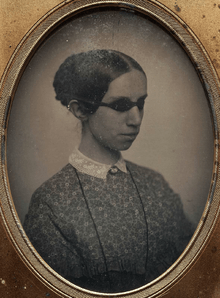Born in Hanover, New Hampshire in December 1892, Laura Bridgman was a member of a hardworking farming family. At 2 years old, she contracted scarlet fever. Two of her siblings died from the illness. Laura survived but she lost most of her senses including sight, hearing, smell and taste. In consequence Laura and her family, and Laura and the outside world could not communicate. She developed a simple form of sign language but frequently became frustrated. By the age of 7 Laura’s father was the only one that could control her, being physically strong enough to overpower and restrain her.

by the Museum of Fine Arts, Boston.
At around the same time a revolutionary school called the Perkins School for the Blind opened. The director of the school had learned about the young girl and her struggles and was keen to help educate her. During this period many with disabilities, especially those who were deafblind were considered lost causes. The director of the school visited Laura at her family home. He convinced the family that this was the best chance Laura had. Laura graced the halls of the Perkins School for the Blind in October 1837.
Laura would be the first deafblind person to be successfully taught a language (English). The director of the school did not support or like the use of sign language. The method that was used was new and would prove innovative for those who were deafblind. The director of the school would give Laura familiar objects or get her to touch familiar items, such as running her fingers under water. He would then place her hand on raised letters that would correspond with the word for the object she had just touched. In this way she learnt the alphabet and the rudiments of spelling. She was then faced with jumbled forms of the words and had to rearrange them to spell the names of the objects. At this point she was considered to have grasped language and communication. It was a long and gradual process.
Laura was a keen student, from the moment she understood that objects had names she wanted to learn the name of everything she encountered. Her vocabulary and communication skills grew massively. Once she had got a grasp on English and spelling she was then taught a full curriculum of reading, writing, geography, maths, history, philosophy etc. At the time this was not only leading the way for the deafblind but also for young girls from working class backgrounds. An education of this kind was almost unheard of for the lower classes at the time and was often an expensive and questionable pursuit for young girls. During her time at Perkins she even encountered famous people of the time. Charles Dickens took a particular interest in her and they met in 1842, when she was 12, an encounter Dickens later reflected on in his book American Notes. Laura’s education ended in 1850 when she was 20. She returned to her family in Hampshire, but as busy farmers they had little patience for her. Her health started to decline. Teachers at the school noticed this and raised money to fund Laura’s return to Perkins. She remained there through Autumn, Winter and Spring, visiting her family in the Summer months. She lived a comfortable life and was able to pursue her hobbies such as reading, needlework and letter writing. She died at the school in 1889 at the age of 59.
